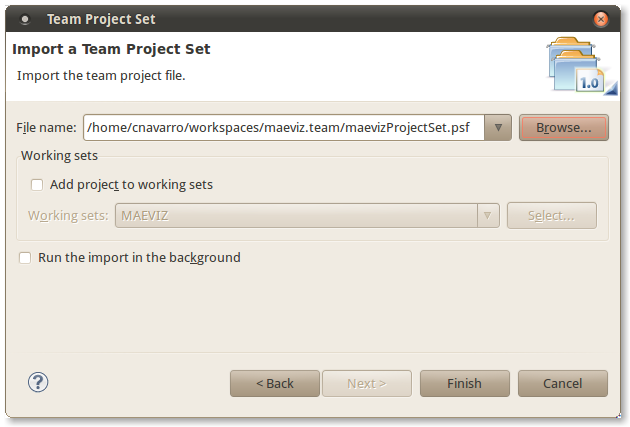...
- Download Eclipse This should work with the latest version of Eclipse; however, it has been tested and verified with Eclipse Galileo SR2 which you can download here. Select the Eclipse for RCP/Plug-in developers download for your system specification.
- Install Eclipse Unpack Eclipse and launch the IDE.
- Get an SVN client for Eclipse Our source code is stored in Subversion, so you will need an SVN client. You canTo install the subversion plug-ins, do the following:
- Go to Help > Install New Software...
- Where it says Work with: select *Galileo - http://download.eclipse.org/releases/galileo*

- Expand Collaboration and select Subversive SVN Team Provider (Incubation) and go through the steps to install it. Restart Eclipse when it asks you to.
- When Eclipse restarts, go to Window > Show View > Other. Expand SVN and select SVN Repositories and click OK. Choose the latest SVN Kit connector (1.30 as of 11/1/2010). Select an SVN Kit connector and click Finish. Go through the steps to install the SVN Kit connectors. Restart Eclipse when it asks you to.
- Connect to the MAEviz source repository Our repository is available read-only from svn://subversion.ncsa.uiuc.edu/ncsa-plugins/ or read-write if you have an account from svn+ssh://<username>@subversion.ncsa.uiuc.edu/CVS/ncsa-plugins/
- Checkout the plugins source Because To simplify the list of plugins in MAEviz is always changing, the most reliable way to determine which plugins to get is by checking the defining product. First, download the
ncsa.maeviz.rcpplugin. Open themaeviz.feature.product(if you are using eclipse 3.5) file, and find the list of features. You will need to check out each of these features. Then, for each feature, you will need to checkout each plugin listed in the feature.xml file. Plugins that are not in our repository are plugins that come with eclipse, and thus do not need to be checked out separately. Alternatively, you may check out all the plugins under ncsa-plugins, which will give you additional plugins that aren't part of MAEviz, but reduces the amount of manual labor in determining which plugins to grab.process of obtaining the latest MAEviz plug-ins we have created a team project set that will download all required plug-ins for MAEviz. To download the project set and import it, do the following:- Go to the MAEviz SVN Repository and expand Trunk. Find the plug-in called maeviz.team and check it out to your workspace
- After the plug-in checks out, go to File > Import and expand Team and select Team Project Set. Click Next.
- Click the Browse button and find the maeviz.team plugin. Go into that plug-in and you should see a file called maevizProjectSet.psf, select it. You should see a screen similar to the one below:
- Click Finish and the MAEviz plug-ins will be downloaded to your workspace automatically. Depending on the speed of your internet connection, this process could take some time.
When all plug-ins are checked out, you can improve the organization of your workspace by selecting Working Sets as your Top-Level Elements in Eclipse. This menu is located in the Package explorer menu (locate the inverted triangle in the Package explorer view), see the image below for the menu location.
MAEviz is developed using the Eclipse RCP platform and Java. Understanding the APIs of these evironments, and how to use Eclipse for development, is outside the scope of this document. Developers will need to be very familiar with Java programming and somewhat familiar with Eclipse RCP to be productive doing MAEviz development.

